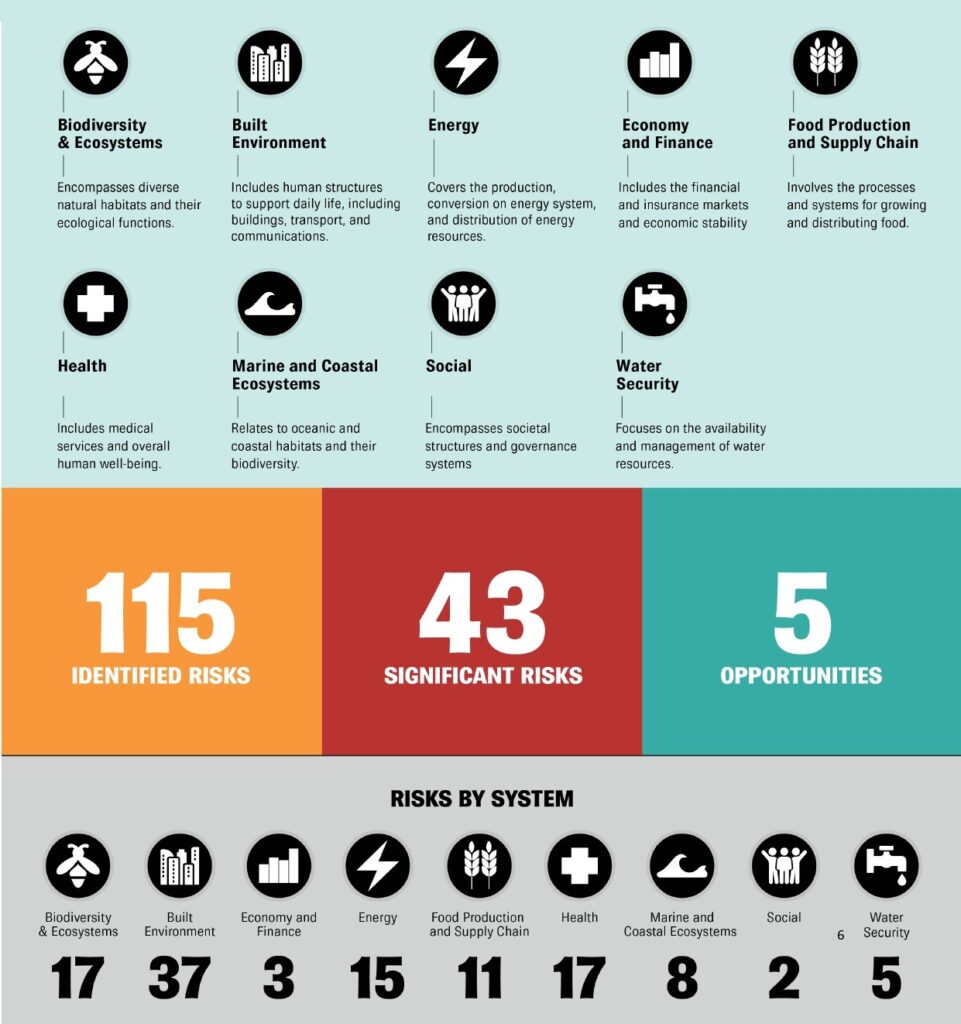Author: Richard Cantwell, Head of Spatial and Sustainability at Gamma
Ireland has taken a significant step toward climate resilience with the publication of its first National Climate Change Risk Assessment (NCCRA). This groundbreaking report, led by the Environmental Protection Agency (EPA), offers a comprehensive, systems-based overview of how climate change could impact Irish society and economy throughout the 21st century.
At Gamma Risk, we see this as a critical moment—not just for government and policymakers, but for insurers, infrastructure providers, and communities across the country.
Understanding the Risks
The NCCRA takes a systems-based approach, identifying 115 climate risks and 7 potential opportunities, grouped across nine societal and economic systems that underpin Irish life. The report uses a three-stage framework: identify, assess, and prioritise climate risks, ultimately determining their decision urgency.
Importantly, risk is assessed based on four key determinants: Hazard, Exposure, Vulnerability, and Risk Potential. This mirrors the standard four building blocks of catastrophe modelling, where risk potential is defined as the insured loss, once insurance terms—such as deductibles, policy limits, and treaty conditions—are applied.
Of the 115 risks identified:
- 43 are considered significant
- 9 are prioritised for urgent national attention
These priority risks are heavily concentrated in:
- Flooding (3 risks),
- Extreme wind events (2 risks),
- Coastal flooding and erosion (2 risks),
- Heat impacts (2 risks)
This systemic structure also allows policymakers to align adaptation strategies with the most exposed areas of Irish society.
Check it out the following graphic that outlines these risks and opportunities, alongside the 9 interconnected systems at the core of the NCCRA’s findings:

Systems Under Threat
Basically, the report takes a systems-based approach, and several systems are flagged as facing catastrophic consequences by the end of the century:
Built Environment
The Built Environment faces the highest level of consequence— categorised as catastrophic — by the end of the century, primarily due to coastal flooding and riverine flood hazards. The report highlights the high probability of damage to buildings, critical infrastructure, and transport networks. With urban expansion continuing in flood-prone areas, this system is highly vulnerable without targeted adaptation measures.
Economy and Finance
The Economy and Finance system is projected to face catastrophic consequences under a high-emissions scenario (RCP 8.5). Notable risks include:
- Increased insurance claims and premiums
- A widening of the flood insurance protection gap
- Asset devaluation and increased default risks
- Reduced government revenues alongside higher public spending and borrowing costs
These findings are aligned with Gamma’s own research with the Central Bank of Ireland, particularly on insurance affordability and availability in flood-prone areas.
Other systems such as Biodiversity, Health, Water Security, Food Supply, and Social Systems are all projected to suffer substantial to critical consequences, underscoring the interconnected nature of climate vulnerabilities.
The Role of Data: From Insight to Action
Generally, one of the strongest messages from the NCCRA is the urgent need for high-quality, consistent data. Gaps in hazard, exposure, and vulnerability data remain a significant barrier to robust climate modelling and effective risk communication.
This is where spatial intelligence plays a crucial role.
At Gamma, we are actively addressing these gaps through solutions like AddressLink, which provides building-level insights into climate hazards, proximity risks, demographics, and more. We believe the integration of such spatial data can greatly enhance climate resilience strategies across both public and private sectors.
Looking Ahead: Closing the Gaps
Although the NCCRA represents a strong starting point, several critical areas are identified for future development. The NCCRA calls for the inclusion of non-climatic risk drivers such as population growth and land-use change. These factors, inherently spatial, can significantly influence climate risk outcomes. Understanding how and where these changes occur is vital for local adaptation planning and national policy development.
As the field evolves, so must our approach. Future iterations of the report should aim to incorporate:
- Financial quantification of direct and indirect climate impacts,
- Transboundary risks and transition risks (currently excluded),
- Compound risk modelling, which reflects real-world interdependencies.
Final Thoughts
The first NCCRA offers more than 700 pages of evidence, insights, and strategic direction. It he sets the foundation for climate resilience in Ireland and outlines a future where climate risk is no longer abstract, but measurable, localised, and urgent.
While the outlook is sobering—particularly for sectors like infrastructure and finance—it also presents a clear roadmap for action. The development of granular, harmonised spatial data will be essential to inform both national frameworks and local adaptation strategies.
Finally, at Gamma Risk, we are committed to enabling informed climate risk planning through advanced spatial analytics. We view the NCCRA not as a final word, but as the beginning of a more integrated, data-led conversation about climate resilience in Ireland.
Let’s move forward—from risk to resilience.


